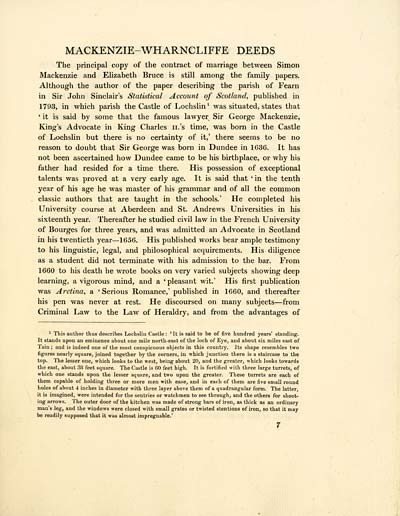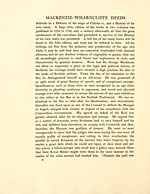Download files
Complete book:
Individual page:
Thumbnail gallery: Grid view | List view

MACKENZIE-WHARNCLIFFE DEEDS
The principal copy of the contract of marriage between Simon
Mackenzie and Elizabeth Bruce is still among the family papers.
Although the author of the paper describing the parish of Fearn
in Sir John Sinclair's Statistical Account of Scotland, published in
1793, in which parish the Castle of Lochslin 1 was situated, states that
' it is said by some that the famous lawyer Sir George Mackenzie,
King's Advocate in King Charles n.'s time, was born in the Castle
of Lochslin but there is no certainty of it,' there seems to be no
reason to doubt that Sir George was born in Dundee in 1636. It has
not been ascertained how Dundee came to be his birthplace, or why his
father had resided for a time there. His possession of exceptional
talents was proved at a very early age. It is said that ' in the tenth
year of his age he was master of his grammar and of all the common
classic authors that are taught in the schools.' He completed his
University course at Aberdeen and St. Andrews Universities in his
sixteenth year. Thereafter he studied civil law in the French University
of Bourges for three years, and was admitted an Advocate in Scotland
in his twentieth year — 1656. His published works bear ample testimony
to his linguistic, legal, and philosophical acquirements. His diligence
as a student did not terminate with his admission to the bar. From
1660 to his death he wrote books on very varied subjects showing deep
learning, a vigorous mind, and a ' pleasant wit.' His first publication
was Aretina, a ' Serious Romance,' published in 1660, and thereafter
his pen was never at rest. He discoursed on many subjects — from
Criminal Law to the Law of Heraldry, and from the advantages of
1 This author thus describes Lochslin Castle : ' It is said to be of five hundred years' standing.
It stands upon an eminence about one mile north-east of the loch of Eye, and about six miles east of
Tain; and is indeed one of the most conspicuous objects in this country. Its shape resembles two
figures nearly square, joined together by the corners, in which junction there is a staircase to the
top. The lesser one, which looks to the west, being about 20, and the greater, which looks towards
the east, about 38 feet square. The Castle is 60 feet high. It is fortified with three large turrets, of
which one stands upon the lesser square, and two upon the greater. These turrets are each of
them capable of holding three or more men with ease, and in each of them are five small round
holes of about 4 inches in diameter with three layer above them of a quadrangular form. The latter,
it is imagined, were intended for the sentries or watchmen to see through, and the others for shoot-
ing arrows. The outer door of the kitchen was made of strong bars of iron, as thick as an ordinary
man's leg, and the windows were closed with small grates or twisted stentions of iron, so that it may
be readily supposed that it was almost impregnable.'
7
The principal copy of the contract of marriage between Simon
Mackenzie and Elizabeth Bruce is still among the family papers.
Although the author of the paper describing the parish of Fearn
in Sir John Sinclair's Statistical Account of Scotland, published in
1793, in which parish the Castle of Lochslin 1 was situated, states that
' it is said by some that the famous lawyer Sir George Mackenzie,
King's Advocate in King Charles n.'s time, was born in the Castle
of Lochslin but there is no certainty of it,' there seems to be no
reason to doubt that Sir George was born in Dundee in 1636. It has
not been ascertained how Dundee came to be his birthplace, or why his
father had resided for a time there. His possession of exceptional
talents was proved at a very early age. It is said that ' in the tenth
year of his age he was master of his grammar and of all the common
classic authors that are taught in the schools.' He completed his
University course at Aberdeen and St. Andrews Universities in his
sixteenth year. Thereafter he studied civil law in the French University
of Bourges for three years, and was admitted an Advocate in Scotland
in his twentieth year — 1656. His published works bear ample testimony
to his linguistic, legal, and philosophical acquirements. His diligence
as a student did not terminate with his admission to the bar. From
1660 to his death he wrote books on very varied subjects showing deep
learning, a vigorous mind, and a ' pleasant wit.' His first publication
was Aretina, a ' Serious Romance,' published in 1660, and thereafter
his pen was never at rest. He discoursed on many subjects — from
Criminal Law to the Law of Heraldry, and from the advantages of
1 This author thus describes Lochslin Castle : ' It is said to be of five hundred years' standing.
It stands upon an eminence about one mile north-east of the loch of Eye, and about six miles east of
Tain; and is indeed one of the most conspicuous objects in this country. Its shape resembles two
figures nearly square, joined together by the corners, in which junction there is a staircase to the
top. The lesser one, which looks to the west, being about 20, and the greater, which looks towards
the east, about 38 feet square. The Castle is 60 feet high. It is fortified with three large turrets, of
which one stands upon the lesser square, and two upon the greater. These turrets are each of
them capable of holding three or more men with ease, and in each of them are five small round
holes of about 4 inches in diameter with three layer above them of a quadrangular form. The latter,
it is imagined, were intended for the sentries or watchmen to see through, and the others for shoot-
ing arrows. The outer door of the kitchen was made of strong bars of iron, as thick as an ordinary
man's leg, and the windows were closed with small grates or twisted stentions of iron, so that it may
be readily supposed that it was almost impregnable.'
7
Set display mode to:
![]() Universal Viewer |
Universal Viewer | ![]() Mirador |
Large image | Transcription
Mirador |
Large image | Transcription
Images and transcriptions on this page, including medium image downloads, may be used under the Creative Commons Attribution 4.0 International Licence unless otherwise stated. ![]()
| Histories of Scottish families > Ancient deeds and other writs in the Mackenzie-Wharncliffe charter-chest > (29) Page 7 |
|---|
| Permanent URL | https://digital.nls.uk/95523713 |
|---|
| Description | A selection of almost 400 printed items relating to the history of Scottish families, mostly dating from the 19th and early 20th centuries. Includes memoirs, genealogies and clan histories, with a few produced by emigrant families. The earliest family history goes back to AD 916. |
|---|

